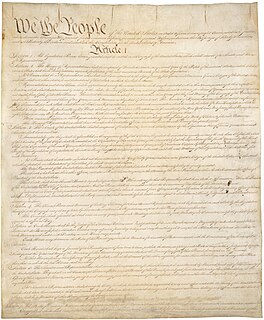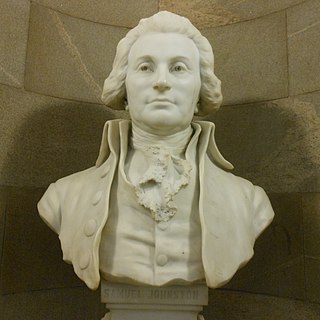
The Constitution of the United States is the supreme law of the United States of America. This founding document, originally comprising seven articles, delineates the national frame of government. Its first three articles embody the doctrine of the separation of powers, whereby the federal government is divided into three branches: the legislative, consisting of the bicameral Congress ; the executive, consisting of the president and subordinate officers ; and the judicial, consisting of the Supreme Court and other federal courts. Article IV, Article V and Article VI embody concepts of federalism, describing the rights and responsibilities of state governments, the states in relationship to the federal government, and the shared process of constitutional amendment. Article VII establishes the procedure subsequently used by the 13 States to ratify it. It is regarded as the oldest written and codified national constitution in force.

The Third Amendment to the United States Constitution places restrictions on the quartering of soldiers in private homes without the owner's consent, forbidding the practice in peacetime. The amendment is a response to the Quartering Acts passed by the British parliament during the buildup to the American Revolutionary War, which had allowed the British Army to lodge soldiers in private residences.

The Seventh Amendment to the United States Constitution is part of the Bill of Rights. This amendment codifies the right to a jury trial in certain civil cases and inhibits courts from overturning a jury's findings of fact.

The 1788–89 United States presidential election was the first quadrennial presidential election. It was held from Monday, December 15, 1788, to Saturday, January 10, 1789, under the new Constitution ratified in 1788. George Washington was unanimously elected for the first of his two terms as president, and John Adams became the first vice president. This was the only U.S. presidential election that spanned two calendar years, without a contingent election.

Anti-Federalism was a late-18th century movement that opposed the creation of a stronger U.S. federal government and which later opposed the ratification of the 1787 Constitution. The previous constitution, called the Articles of Confederation and Perpetual Union, gave state governments more authority. Led by Patrick Henry of Virginia, Anti-Federalists worried, among other things, that the position of president, then a novelty, might evolve into a monarchy. Though the Constitution was ratified and supplanted the Articles of Confederation, Anti-Federalist influence helped lead to the passage of the Bill of Rights.

Article Seven of the United States Constitution sets the number of state ratifications necessary in order for the Constitution to take effect and prescribes the method through which the states may ratify it. Under the terms of Article VII, constitutional ratification conventions were held in each of the thirteen states, with the ratification of nine states required for the Constitution to take effect. Delaware was the first state to ratify the Constitution, doing so on December 7, 1787. On June 21, 1788, New Hampshire became the ninth state to ratify the Constitution, ensuring that the Constitution would take effect. Rhode Island was the last state to ratify the Constitution under Article VII, doing so on May 29, 1790.

The United States Constitution has served as the supreme law of the United States since taking effect in 1789. The document was written at the 1787 Philadelphia Convention and was ratified through a series of state conventions held in 1787 and 1788. Since 1789, the Constitution has been amended twenty-seven times; particularly important amendments include the ten amendments of the United States Bill of Rights and the three Reconstruction Amendments.

The Constitutional Convention took place in Philadelphia from May 25 to September 17, 1787. Although the convention was intended to revise the league of states and first system of government under the Articles of Confederation, the intention from the outset of many of its proponents, chief among them James Madison of Virginia and Alexander Hamilton of New York, was to create a new government rather than fix the existing one. The delegates elected George Washington of Virginia, former commanding general of the Continental Army in the late American Revolutionary War (1775–1783) and proponent of a stronger national government, to become President of the convention. The result of the convention was the creation of the Constitution of the United States, placing the Convention among the most significant events in American history.

Federalist No. 85 is an essay by Alexander Hamilton, the eighty-fifth and last of The Federalist Papers. It was published on August 13 and 16, 1788 under the pseudonym Publius, the name under which all The Federalist papers were published. The title is "Concluding Remarks".

The Missouri Compromise was a United States federal legislation that stopped northern attempts to forever prohibit slavery's expansion by admitting Missouri as a slave state and Maine as a free state in exchange for legislation which prohibited slavery in the remaining Louisiana Purchase lands north of the 36°30′ parallel except for Missouri. The 16th United States Congress passed the legislation on March 3, 1820, and President James Monroe signed it on March 6, 1820.

The Virginia Ratifying Convention was a convention of 168 delegates from Virginia who met in 1788 to ratify or reject the United States Constitution, which had been drafted at the Philadelphia Convention the previous year.

The United States Bill of Rights comprises the first ten amendments to the United States Constitution. Proposed following the often bitter 1787–88 debate over the ratification of the Constitution, and written to address the objections raised by Anti-Federalists, the Bill of Rights amendments add to the Constitution specific guarantees of personal freedoms and rights, clear limitations on the government's power in judicial and other proceedings, and explicit declarations that all powers not specifically granted to the federal government by the Constitution are reserved for the states or the people. The concepts codified in these amendments are built upon those found in earlier documents, especially the Virginia Declaration of Rights (1776), as well as the Northwest Ordinance (1787), the English Bill of Rights (1689), and Magna Carta (1215).

The drafting of the Constitution of the United States began on May 25, 1787, when the Constitutional Convention met for the first time with a quorum at the Pennsylvania State House in Philadelphia, Pennsylvania to revise the Articles of Confederation. It ended on September 17, 1787, the day the Constitution drafted by the convention's delegates to replace the Articles was adopted and signed. The ratification process for the Constitution began that day, and ended when the final state, Rhode Island, ratified it on May 29, 1790.

The Congressional Apportionment Amendment is a proposed amendment to the United States Constitution that addresses the number of seats in the House of Representatives. It was proposed by Congress on September 25, 1789, but was never ratified by the requisite number of state legislatures. As Congress did not set a time limit for its ratification, the Congressional Apportionment Amendment is still pending before the states. As of 2021, it is one of six unratified amendments.

The Country Party was a political party in Rhode Island in the Confederation and early Federal periods, from about March 1781 until the death in office of its leader, Governor Arthur Fenner, in October 1805. At its peak of influence, it controlled the Rhode Island General Assembly and dominated state politics from 1785 to 1790. A stridently Anti-Federalist party, it was instrumental in resisting ratification of the Constitution and was the organized vehicle for political expression of popular views that led to Rhode Island both disrupting consensus among states under the Articles of Confederation and being the last of the original 13 states to ratify the Constitution.
The Confederation Period was the era of United States history in the 1780s after the American Revolution and prior to the ratification of the United States Constitution. In 1781, the United States ratified the Articles of Confederation and prevailed in the Battle of Yorktown, the last major land battle between British and American forces in the American Revolutionary War. American independence was confirmed with the 1783 signing of the Treaty of Paris. The fledgling United States faced several challenges, many of which stemmed from the lack of a strong national government and unified political culture. The period ended in 1789 following the ratification of the United States Constitution, which established a new, more powerful, national government.

The Hillsborough Convention, was the first of two North Carolina conventions to ratify the United States Constitution. Delegates represented 7 boroughs and 59 counties, including six western counties that became part of Tennessee when it was created in 1796. They met in Hillsborough, North Carolina from July 21 to August 4, 1788 to deliberate and determine whether to ratify the Constitution recommended to the states by the General Convention that had been held in Philadelphia the previous summer. The delegates had won their seats through special elections held in March 1788, as mandated by the North Carolina General Assembly. Governor Samuel Johnston presided over the Convention. The Hillsborough Convention was dominated by anti-Federalists, and North Carolina did not ratify the Constitution until the Fayetteville Convention, which met a year later.

The Fayetteville Convention was a meeting by 271 delegates from North Carolina to ratify the US Constitution. Governor Samuel Johnston presided over the convention, which met in Fayetteville, North Carolina, from November 16 to 23, 1789 to debate on and decide on the ratification of the Constitution, which had recommended to the states by the Philadelphia Convention during the summer of 1787. The delegates ratified the Constitution by a vote of 194 to 77, thus making North Carolina the 12th state to ratify the constitution.
The New York Circular Letter was a solution reached in a controversy between Federalists and Anti-Federalists over ratification of the United States Constitution. The compromise built on earlier deals like the Massachusetts Compromise to call for the use of the Convention provision written into the newly ratified Constitution in order to get the amendments demanded by New York and other states.

The first election for Virginia's 5th congressional district took place on February 2, 1789, for a two-year term to commence on March 4 of that year. In a race that turned on the candidates' positions on the need for amendments to the recently ratified U.S. Constitution, James Madison defeated James Monroe for a place in the House of Representatives of the First Congress. It is the only congressional election in U.S. history in which two future presidents opposed each other.










